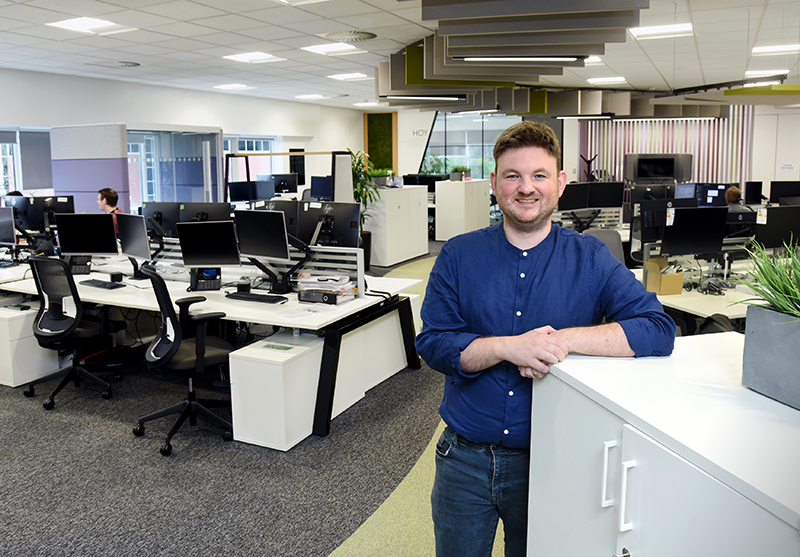
AN architect has vowed to help more young deaf people into the profession after becoming only the second deaf person in Scotland to achieve the Final Certificate in Architecture, APEAS Part 3.
Ryan Johnston, who works for design, engineering, and project delivery company BakerHicks, passed the final assessment in March, which enables individuals to register under the Architects Act 1997.
Ryan told Project Scotland the achievement is not the finish line, but merely the starting point – as he looks forward to developing his skillsets with the increased responsibility at BakerHicks that the qualification enables.
Recent work by Ryan includes a project to transform the King George VI building in his hometown of Port Glasgow. The 18th century, B-listed structure is being sympathetically restored to be used as a community building, as well as being made carbon zero in line with Inverclyde Council’s net zero ambitions.
The journey to get to where he is today has been no mean feat for Ryan. From day one he had his expectations managed, with teachers often gently downplaying his ambitions in an attempt to guard him from more brutal rejections further down the line.
“You’re never being too ambitious; your ambitions belong to you,” Ryan said. “You need to work towards your goals and follow your own path; it’s important that you don’t take negativity onboard and stick to your guns.”
Ryan’s interest in the built environment led to him enrolling in the Mackintosh School of Architecture in 2008. However, finding a British Sign Language interpreter willing to commit to the course full-time proved ‘impossible’ – often leaving him with no interpreter for some classes.
With architectural terms not existing in British Sign Language, it is left to individuals and their interpreters to create their own terms within the language – with this requiring both to fully understand the architectural subject to co-create and use the signs.
This left Ryan with the arduous task of getting numerous different interpreters up to speed with not only whatever point he was at in his studies, but also his language. This ultimately led to an entire year being written off after one interpreter opted for a career change and left just before a final exam.
“Under normal circumstances, deaf people would share language information – but if you’re not working in architecture, you’ve got no reason to use it,” Ryan explained. He now intends on collaborating with other British Sign Language users who are working towards becoming an architect to create a codified system for the future.
“There needs to be a coming together; there needs to be a consolidation of the works taking place in British Sign Language development in the architectural context.”
With a codified language for architecture, it is hoped that a more seamless journey through the educational system is guaranteed – with Ryan’s taking 16 years rather than the standard seven. “It’s been a long journey and a difficult one; it took me a lot longer than everybody else because of some of the barriers I faced,” Ryan revealed, before telling how he went three years without a training place despite being qualified for the vacancies he was applying for.
Ryan’s perseverance eventually paid off after he landed a temporary post at an architecture practice, which was extended to four years, before he and others at the firm were notified that their contracts would be ending as it looked to reduce its team.
In a panic as his Part 3 exam loomed, the impending job loss turned out to be a blessing for Ryan. Applying to BakerHicks, he was delighted when the firm quickly took him on.
“I really feel so lucky and relieved to be working in a supportive environment like the one we’ve got here at BakerHicks,” he said. “The quality of teamwork here is so high. There’s a learning culture here where everybody shares information openly and freely with team members – and I’ve benefited from that immensely.”
Ryan works alongside interpreter John Dunipace, who now has half a decade of architectural study under his belt. BakerHicks is currently putting Ryan’s colleagues through a British Sign Language course, with the architect saying he couldn’t ask for a more supportive and thoughtful team. Ryan and his colleagues are set to visit local schools to deliver STEM sessions and highlight that a deaf person can achieve whatever they want to with the correct mindset and support in place.
Much of Ryan’s own mindset is down to his late father, who sadly passed away one week before his Part 3 exam – telling his son in the eleventh hour to ‘see it to the end’.
“My dad would always say: ‘you need to fight for what you want, son; if you’ve got a dream nobody’s going to achieve it for you, only you’. My father had a traditional attitude to work and a very good work ethic. When I was at university, he couldn’t have been any more proud – and I know that he’s proud of me up there.
“It’s been such a long journey for me; there’s been so many challenges and there’s been so many people who said I couldn’t do it, and here I am now.
“Am I still learning? Of course I am, and I’m going to be learning for a long time as methods and building practices change as a result of the carbon zero agenda – and I’m very, very motivated to continue the work.”











